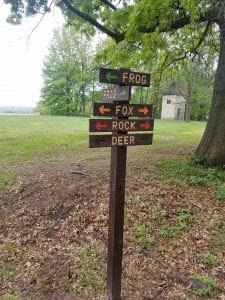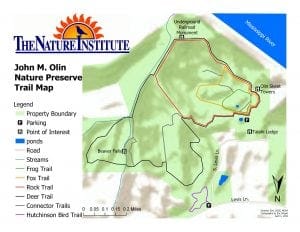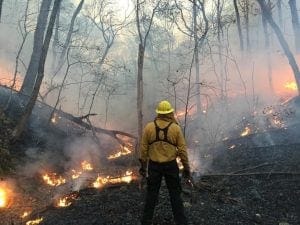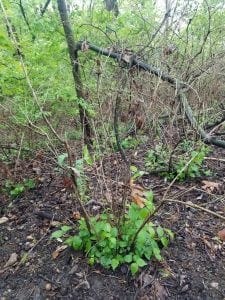Written by Eric Wright, TNI stewardship director
Three things to look for on the trails at TNI
The trails at The Nature Institute are back open and we want to thank you for your patience as the preserves were rested over the winter. While hikers were staying warm inside during the winter months, our staff worked diligently to improve our properties. Here are a few things to expect when you visit in 2019.
We sat down this winter and tweaked our trail map and trail signs. Hikers can now use our new map and trail signs to more easily create a multitude of hiking experiences. Like our old map, the locations of TNI’s landmarks are still noted, but hikers can now select a loop based on desired distance, time, and difficulty level. Trail intersections are marked with trail names and directional arrows. You can use the newly named Frog Loop to take a short stroll to see the hill prairie overlooking the Mississippi River, or you can commit a couple hours and tour the whole property on the Deer Trail.
Historically, wild fires periodically swept through our local ecosystems. Native plants evolved alongside these naturally occurring fires and adapted to survive and even benefit from these seemingly horrific events. Fire clears off dead growth from previous years causing some plant populations to decrease while causing others to increase as nutrients and space become available. Immediately after a burn, the land is literally black. Stewardship staff uses prescribed fire to mimic historical fire regimes. Despite wet conditions for most of the winter, we were able to perform multiple prescribed burns. Look out for invigorated growth in burned areas or a “top killed” tree or shrub as you cruise through the properties.
TNI has the full spectrum of invasive species known to our area plus a few that are only locally known. Invasive species outcompete and replace native species causing an overall reduction in biodiversity. Our goal at TNI is to promote high biological diversity within the habitats that we manage. The stewardship team has been aggressively battling bush honeysuckle, oriental bittersweet, Japanese hops and many more species for years. Evidence of this battle can be seen from the trails by observing the skeletons and stumps of fallen bush honeysuckle and the dangling dead vines of oriental bittersweet. As our native plants return in abundance, the evidence of this battle will begin to fade. Please enjoy as new areas can be seen from the trails and our native wildflowers return.
Now that the weather is beautiful and the trails are open, we hope you come out and explore. We bet if you keep your eyes open, you will find something you have never noticed before.




Leave A Comment